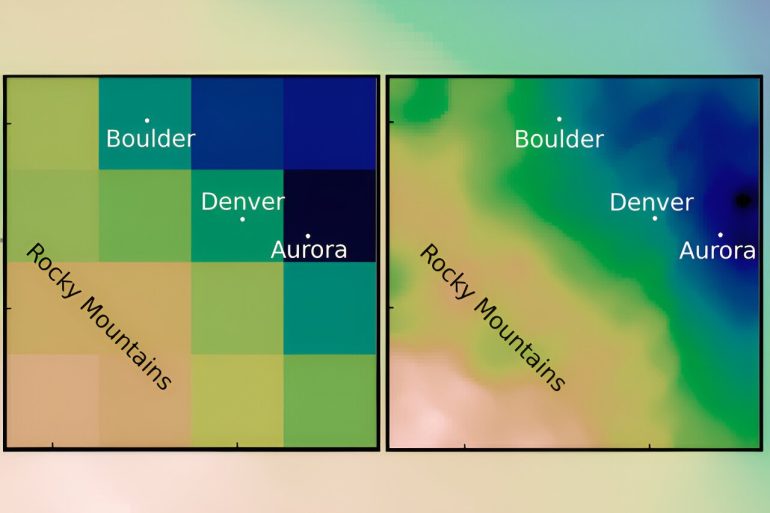- Climate models are pivotal for predicting climate change impacts.
- Traditional models struggle with local-scale accuracy and computational costs.
- Researchers integrate machine learning to enhance current models.
- Adversarial learning helps generate super-resolution data efficiently.
- Streamlining physics and leveraging historical data improve model accuracy.
- Minimal training data required, reducing time and resources.
- Swift model deployment aids stakeholders in risk assessment and decision-making.
- Future focus includes extending model scope to critical variables beyond extreme precipitation.
Main AI News:
Cutting-edge advancements in climate modeling are revolutionizing our ability to forecast the impacts of climate change. These models serve as indispensable tools, providing insights into phenomena like sea-level rise, flooding, and temperature escalation, thereby empowering policymakers to make informed decisions. However, existing climate models face limitations in swiftly delivering actionable insights at smaller scales, such as municipal levels.
In a groundbreaking study published in the Journal of Advances in Modeling Earth Systems, researchers have pioneered a novel approach that harnesses the power of machine learning to harness the capabilities of current climate models while significantly reducing computational overhead.
“This paradigm shift challenges conventional wisdom,” remarks Sai Ravela, a principal research scientist at MIT’s Department of Earth, Atmospheric and Planetary Sciences (EAPS), who co-authored the paper with EAPS postdoctoral researcher Anamitra Saha.
Redefining Traditional Approaches
Conventionally, in climate modeling, downscaling involves refining global climate models with coarse resolutions to capture finer details within specific regions. Analogous to manipulating a digital image, downscaled models zoom into targeted areas, such as Boston, from a broader, low-resolution view, akin to a pixelated picture. However, due to the inherent limitations of this process, the resulting models often lack the necessary precision to be effectively utilized.
“Transitioning from coarse to fine resolution necessitates the incorporation of additional information,” elucidates Saha. Typically, this involves blending theoretical models with statistical data gleaned from historical observations, a computationally intensive endeavor that strains resources.
A Fusion of Innovation
In their seminal paper, Saha and Ravela introduce a pioneering method to enrich models with data through adversarial learning, a machine learning technique. This approach employs two interconnected machines: one generates data while the other evaluates its authenticity against real-world data. Through iterative refinement, the process aims to produce super-resolution data sets.
While machine learning integration in climate modeling is not novel, its efficacy has been impeded by its inability to handle intricate physics, such as conservation laws. By streamlining the physics and augmenting it with statistical insights, the researchers achieved remarkable outcomes.
“By synergizing machine learning with statistical data and simplified physics, we’ve unlocked transformative potential,” asserts Ravela.
Their methodology initially focused on forecasting extreme rainfall, simplifying complex equations and emphasizing key factors like water vapor and terrain topology. The resultant models accurately depicted rainfall patterns across diverse landscapes, leveraging historical data for calibration.
“The hybrid approach delivers the precision of physics-based models at a fraction of the computational cost,” adds Ravela.
Moreover, the researchers were surprised by the minimal training data required, underscoring the efficiency of their methodology. Training sessions, lasting mere hours, yield rapid results, a marked improvement over conventional models requiring months to execute.
Expediting Risk Assessment
The ability to swiftly deploy these models is invaluable for stakeholders like insurance firms and local authorities. For instance, in regions like Bangladesh, timely insights into the potential impact of extreme weather events facilitate informed decision-making regarding agriculture, urban planning, and disaster preparedness.
“We cannot afford lengthy delays in risk assessment,” emphasizes Ravela. “Our models enable stakeholders to navigate future scenarios with a high degree of certainty, accounting for myriad uncertainties.”
While the current focus lies on extreme precipitation, the researchers are actively extending their model’s scope to encompass other critical variables like tropical storms, winds, and temperature fluctuations. This expansion is poised to enhance preparedness and resilience in vulnerable regions like Boston and Puerto Rico.
“We’re not only enthralled by the methodological advancements but also by the transformative applications they entail,” concludes Ravela.
Conclusion:
The integration of machine learning techniques into climate modeling represents a significant breakthrough, addressing longstanding challenges in accuracy and computational efficiency. This innovation not only enhances risk assessment capabilities but also opens new avenues for market opportunities, particularly in sectors reliant on precise climate data, such as insurance, urban planning, and agriculture. As stakeholders increasingly prioritize resilience and sustainability, solutions that offer rapid, localized insights will be in high demand, positioning organizations at the forefront of this technological advancement for strategic advantage.

